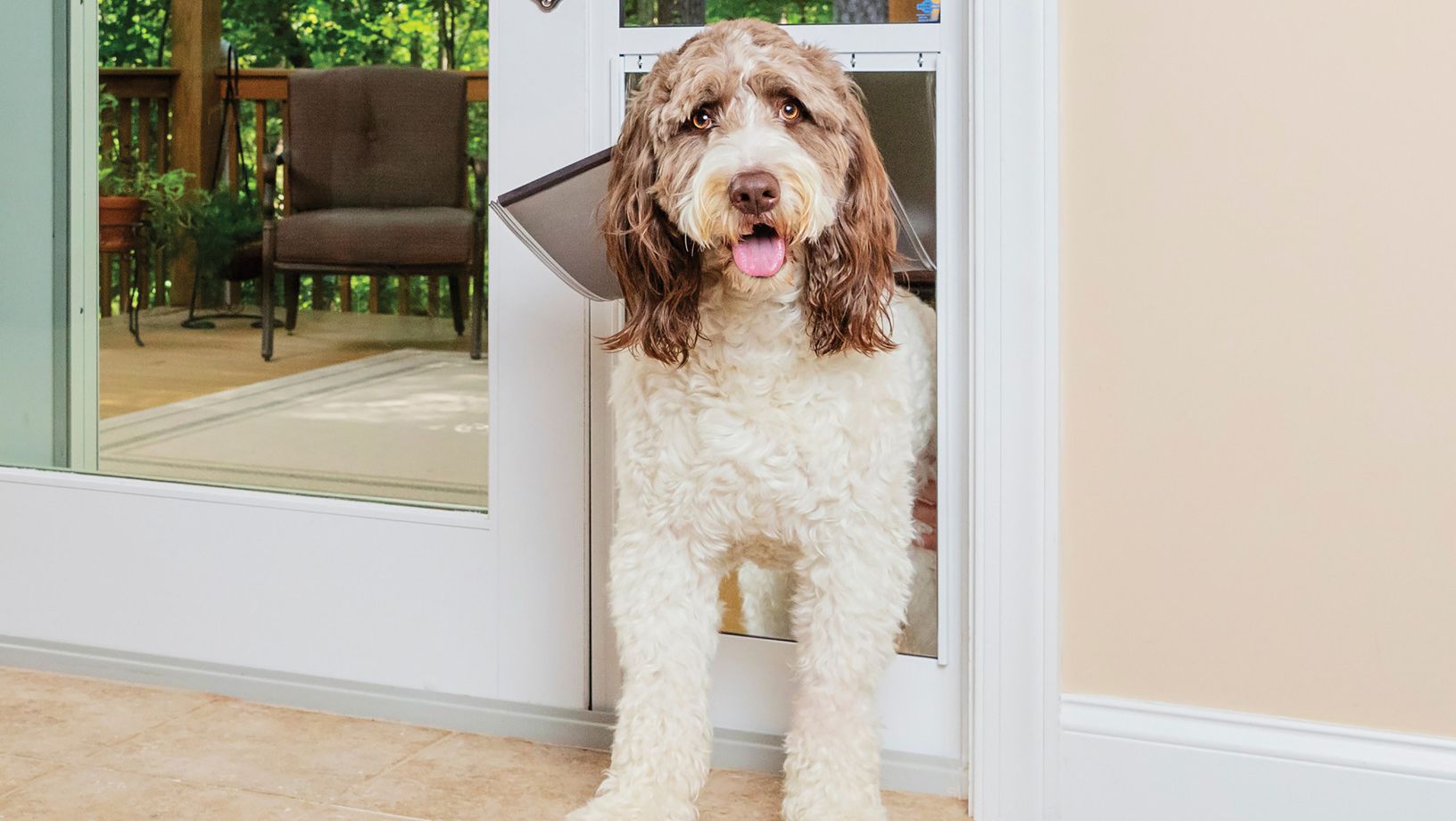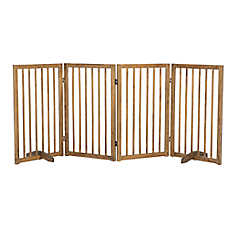Dog Doors: Freedom for You and Your Pup

In this Article
While every day with a dog is full of joy and companionship, there is one small inconvenience: frequent potty breaks. Whether it’s in the middle of dinner, during your favorite TV show or after you’ve gone to bed, your pup’s potty needs often seem to come at the most inopportune times.
That’s where dog doors can be a huge timesaver. These convenient solutions give your dog easy access to the outdoors for bathroom breaks and exercise while sparing you the task of constantly running to open and close the door.
The keys to using dog doors successfully are choosing the right kind of door for your home and your needs, managing security and addressing weatherproofing concerns.
What are dog doors, exactly?
A dog door is a small, specialized opening installed in a door, wall or window that allows your pup to go in and out of the house without assistance. Dog doors come in various sizes and styles designed for different breeds and homes. Most doors feature a flap or a panel that swings or slides to let your dog through. Modern dog doors also feature smart technology to enhance security.
Types of dog doors
There are many types of dog doors available, each with unique features tailored for different needs.
- Flap dog doors are the most common type. These feature an opening with a flexible flap that your dog pushes through to go in and out of the house. These doors may be single-flap or double-flap for added installation and weatherproofing.
- A dog door for a sliding glass door features an insert built directly into the glass door panels. This allows for easy installation without having to modify your existing door.
- Electronic dog doors, or automatic dog doors, are equipped with sensors that detect signals from a special collar tag and that open only for your pet to prevent unwanted animals from entering. Some electronic doors also work with your dog’s microchip.
- Wall-mounted doors are installed through an exterior wall rather than a door. This type of door typically requires professional installation.
- Bump-out doors are little additions the size of a dog house to the side of your home, creating a barrier between the outside and the interior of your home.
The pros and cons of dog doors
Dog doors offer many advantages – and several drawbacks.
Pros:
- Convenience: You don’t need to constantly run to the door when your dog needs to go out, saving you time and hassle.
- Independence: Dog doors let your pup access the outdoors without your help when they need to relieve themselves, get some fresh air or for playtime.
- Mental stimulation: Allowing your dog to explore outdoor areas alleviates boredom, potentially reducing destructive behaviors like chewing or excessive barking.
- Supports potty needs: Dog doors are helpful for puppies when learning bathroom habits as well as older dogs who may need to make more frequent trips outside.
Cons:
- Security risks: Unsecured doors may allow unwanted animals or intruders into a home.
- Energy loss: If a door isn’t properly insulated, it may increase your heating and cooling costs.
Choosing the right dog door
Keep these criteria in mind when considering which door is best for you and your pup.
- Size: The door should be large enough for your dog to pass through comfortably but not so large that it allows other animals or people to crawl through.
- Security: Consider doors with locking mechanisms or electronic features that prevent unwanted animals or intruders.
- Energy efficiency: Depending where you live, you may want doors with insulated flaps or multi-flap designs that provide a better seal to reduce energy loss.
- Durability: It’s wise to choose a dog door made from high-quality materials that will withstand constant use and weather conditions.
Safety considerations
Even with a dog door, it’s important to supervise your pup when they’re outside. With fenced-in backyards, there may be gates left open, holes in fences or wildlife that can get into the yard. Additionally, it’s important to review winter pet safety and heat and summer safety tips for dog, to ensure your dog is safe during extreme hot and cold temperatures.
Training your dog to use the door
Training your dog to use a door can take a little time and patience, but with practice, most dogs can pick it up easily. Here’s a step-by-step guide:
- Prop the door open: Leave the door flap open so your dog can see the opening clearly, allowing them to get used to the idea of going through the door before adding the challenge of pushing through the flap.
- Use treats and toys as motivation: Encourage your dog to go through the door by standing on the opposite side and using treats or a favorite toy to lure them through.
- Introduce the flap: Once your pup is comfortable walking through the door, let the flap down but hold it slightly ajar and encourage them to push through, using a treat for motivation. Practice going through in both directions.
- Phase out treats: Once your dog is using the door regularly, you can reduce the use of treats and encourage them to go through the door on command.
FAQs
Are doggy doors good for dogs?
Yes, dog doors can be great for dogs as they offer independence, promote exercise and reduce accidents by allowing dogs to relieve themselves when needed. However, they should only be used if your yard is safe and secure.
Is it better to put a dog door in the wall or door?
It depends on your home’s layout and your personal preferences. Wall-mounted doors offer more flexibility in placement, while door-mounted options are easier and less expensive to install. Choose based on the option that provides the safest and most convenient access to your yard.
How safe is a doggie door?
Dog doors with locking mechanisms, electronic controls or smart features are generally safe. However, you’ll want to ensure that your yard is secure. Choosing the right door size and security features are essential to prevent intruders or unwanted animals.
Do dog doors also work as cat doors?
Yes, dog doors can work as cat doors, if the door is the right size for both animals. Many pet doors are designed to accommodate both dogs and cats, allowing them to share the same access.
What are alternatives to dog doors?
If you’re not sure a dog door is for you or your pup, there are other options for letting your dog outdoors safely. You might use dog gates and dog fences to allow your dog access to a patio, garden space or dog run, giving them freedom to go outside while keeping them in a controlled area.
Need other supplies while you’re shopping for dog doors? PetSmart also carries dog food, dog beds, dog treats, leashes & harnesses, flea & tick meds and more. Explore PetSmart’s Dog Shop to find everything your pup needs, all in one place.
PetSmart also offers services such as dog grooming services, expert dog training, safe and comfortable PetsHotel stays, and Doggie Day Camp for your pup to play and socialize. Services are available in select locations—check your local PetSmart to see what’s offered near you.
PetSmart offers convenient shopping with Curbside Pickup or in-store pickup. Need something today? We have select items available for Same-Day Delivery in most areas powered by DoorDash. For items you purchase frequently, PetSmart has Autoship that automatically delivers the items you want to your door as often as you’d like. Check the website to see which items are eligible.
Information in this article is not intended to diagnose, treat or cure your pet and is not a substitute for veterinary care provided by a licensed veterinarian. For any medical or health-related advice concerning the care and treatment of your pet, contact your veterinarian.




